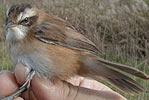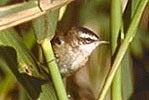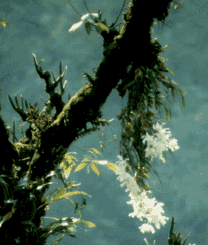 |
2003 |
|
 |
|
Siberian
cranes and Sarus cranes in Koshi Tappu Wildlife Reserve January
2003
|
 |
Siberian crane
Sarus
crane
Leaving the chilly Siberian winter, the Sarus Cranes have arrived it to Nepal this
year too. The migratory birds were first spotted along the banks of the
Pasaha River in Hariya VDC of Bara district. However, the cranes weighing
around five to seven kg, started arriving since the third week of December,
two weeks later than last year. |
 |
The
birds prey on the fish in the river and spend the whole day around the
river, warming themselves in the sun. Various species of birds, including
the Sarus Crane, migrate to the Koshi Tappu Wildlife Reserve in Bara district,
eastern Nepal, as freezing winter takes hold in Siberia.
The
Sarus Crane, locally known as 'Dhanesh' were extinct in the district due
to poaching a decade ago. Poachers kill the bird as its powdered bones,
is said to be an effective medicine for rheumatism and repair of broken
human bones.
top
|
Encroachment
threatens Black bucks in Bardiya January 2003
|
 |
Black Buck
The
species of Black Bucks which are considered very rare in the world, and
which are found only in the Khairapur region of the Bardia district are
in risk due to human intervention and perilous environment due to encroachment.
Due to open environment for grazing cattle, and uncontrolled groups of
people thronging to collect grass and fodder, these bucks which love quiet
surroundings are found to be moving from one place to another. |
These
animals are easily agitated by big noises. Though 708 Bigha of land about
600 kilometres away from the district headquarters has been set-aside for
it, yet its habitat area is gradually getting constricted due to human
encroachment and mushrooming up of residential areas. Till now no organisation
has shown any interest in its management and protection, even though this
region is of immense significance. At present this region has just one
check post with a staff of seven persons.
Some
years ago these Black Bucks used to be found in plenty in the Banke and
Bardia, but their number drastically decreased with the introduction of
the Malarial control programme. These bucks which were on the verge of
extinct have however,increased now to 74. This region which could have
easily been developed into a tourist spot has not even been able to attract
even domestic tourists due to lack of proper means of communication, and
the nominal facilities for the visitors.
top
|
Sukla
Phanta Wildlife Reserve: Moustached Warbler located January
2003
|
 |
Moustached Warbler (Acrocephalus melanopogon)
A
new bird species in Nepal, the Moustached Warbler (Acrocephalus melanopogon),
has been recorded at the Sukla Phanta Wildlife Reserve. The bird was sighted
for the first time in Nepal along the edge of Rani Tal marshes of
Sukla Phanta Wildlife Reserve.
|
 |
The
moustached warbler belongs to the family Sylviidas and subfamily Acrocephalinae.
It
has a distinct, broad white supercilium, a darker stripe through its eye,
dark ear-coverts, whitish throat, light rufous unstreaked rump, streaked
head and back. According to the team, its call appears to be thicker than
any other Acrocephalus occurring in Sukla Phanta, said the release.This
species mostly inhabits open edges of marshy grassland. Within the Indian
subcontinent, the newly recorded bird is found in India and Pakistan as
winter visitor.
With
the sighting of this bird, the total number
of birds found in Nepal has reached 859.
|
Charikot
- Dolakha: Orchid on the verge of extinction September
2003
|
 |
Orchids The
orchid plant, used as essence in various herbal products, perfumes, chocolate
and incense, is on the verge of extinction in Dolkaha district as a result
of its unrestricted collection. This plant species is under constant threat
of extinction after the local people, attracted by its market value, started
collecting the plant in the wild in a haphazard manner without acquiring
license for its collection. Although orchid is found abundantly in the
forests of Dolakha, botanists and conservationists have started expressing
the fear that the orchid plant which is known for its multi-coloured flowers
will disappear altogether in time if the rampant collection is not restricted.
Seventy-five percent of the orchid grows in the wild at an altitude of
700-2,500 metres from the sea level. It is found more abundantly especially
in the eastern parts of Nepal. Out of some 36,000 species of orchids found
in the world, between 350-360 species are found in Nepal. |
Orchid,
which falls under the genus 'epiphytic', grows on rock-cliffs and tree
branches. It is also widely preferred for home decoration and is an important
garden plant. At present orchid collection is going on rampantly in forest
areas of Jiri, Mirgey, Kavre and Thulopatal Village Development Committees
in the district. The District Forest Office is well aware of the rampant
collection of orchid going on in the district but the practice goes on
in an unrestricted manner in the absence of effective steps and lack of
awareness on the part of the local people.
It
is now being realised that collection of such invaluable forest resources
should be done in a scientific way and measures taken for their preservation.
Extensive public awareness needs to be created for this purpose.
|








